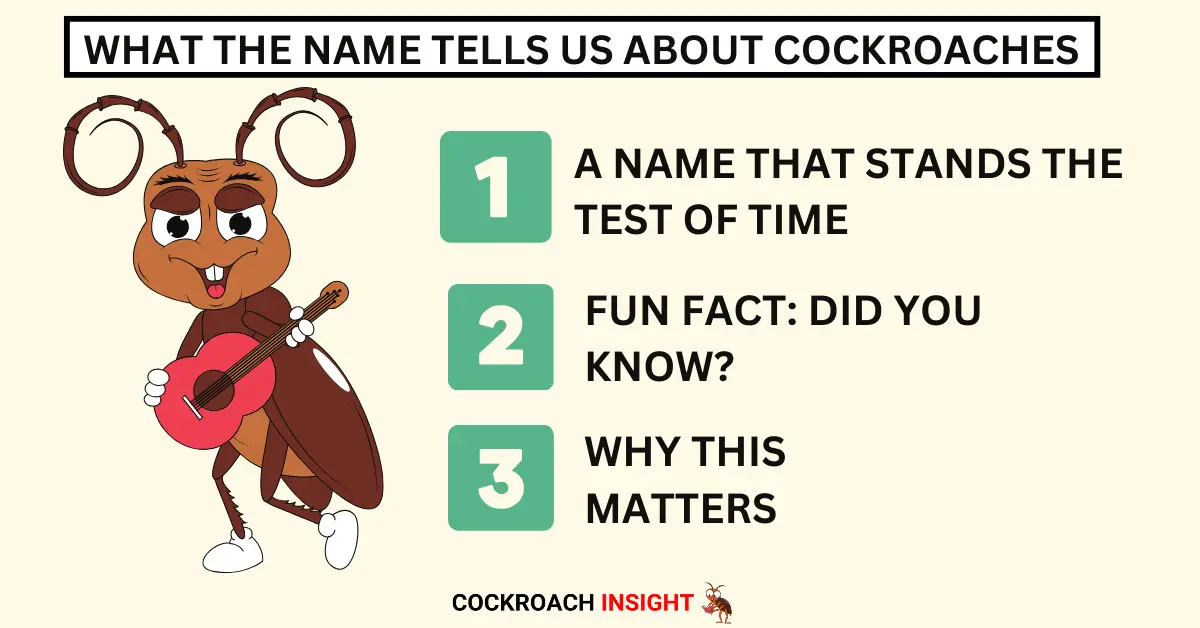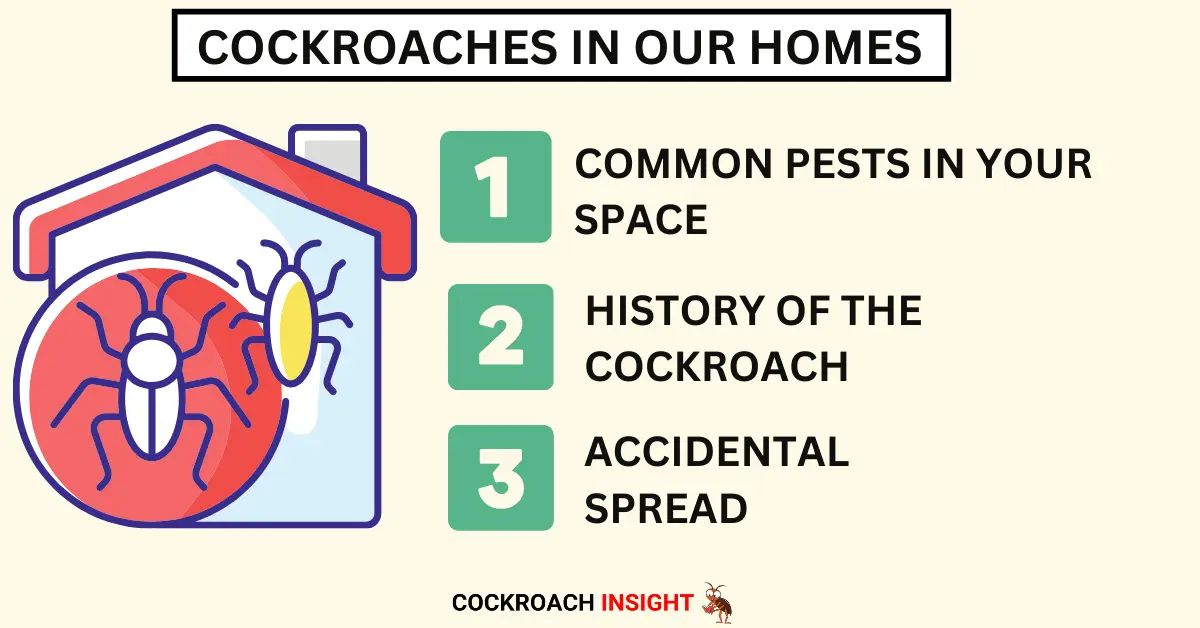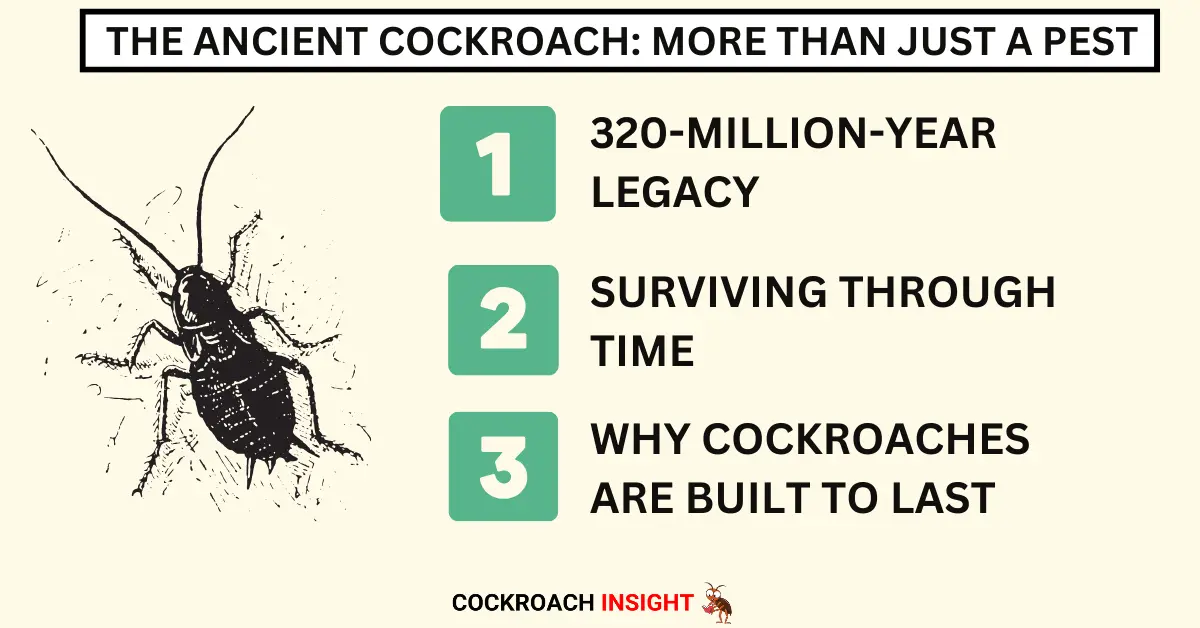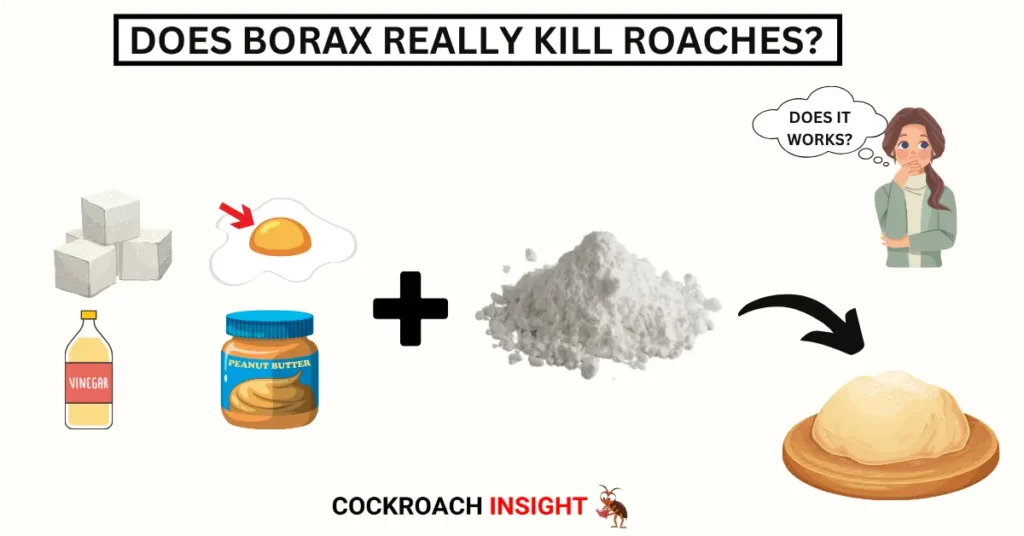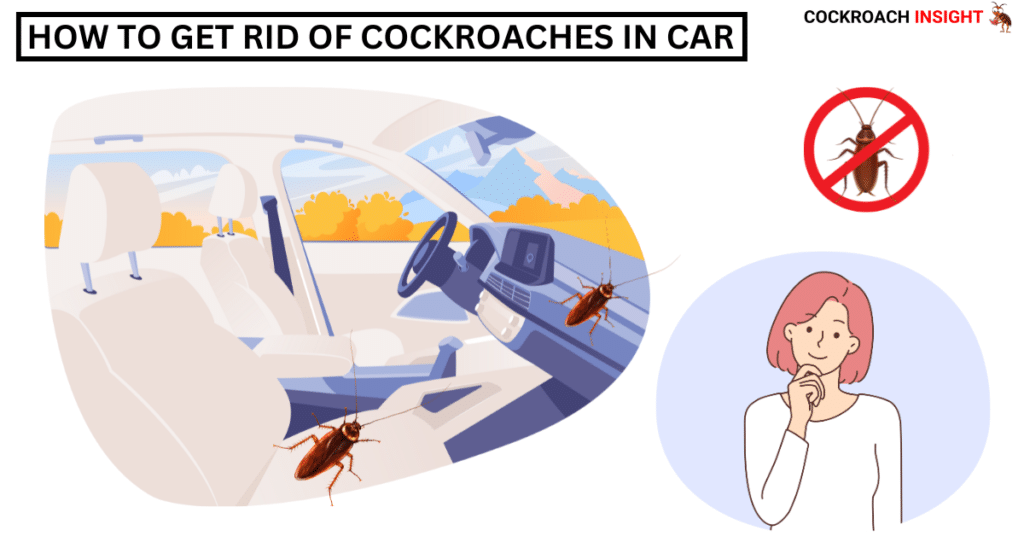Every person has seen cockroaches scurrying across their kitchen floors or finding refuge in shadowed areas. Have you ever stopped to consider the origin of their name? Why are they called “cockroaches”? The word cockroach carries a curious history behind it.
The sight of cockroaches in my home triggered the same question in my mind. The initial concern I had was only about roach elimination.
The name “cockroach” derives from their specialized survival abilities, which enable them to thrive in numerous environments regardless of conditions—leading to their persistent existence as pests.
This writing examines the origins of the term “cockroach” while providing details about these pests along with lesser-known aspects of their nature.
This article will help you understand why these insects survived through millions of years and show why they will persist for long into the future.
Where Did the Word “Cockroach” Come From?
According to Britannica the term “cockroach” originates from the Spanish word “cucaracha.” English speakers heard the Spanish word “cucaracha” but mispronounced it, so it became “cockroach” through time.
This type of word change is called folk etymology, which happens when people hear a foreign word and adapt it to something that sounds more familiar in their own language.
How the Name Connects to Their Behavior
People acknowledge cockroaches through two things – their remarkable toughness and their ability to inhabit any environment. People have kept their name for numerous generations in exactly the same way insects exist today.
In many cultures, cockroaches are linked to being dirty, sneaky, and incredibly hard to get rid of, which is why their name often carries a negative meaning.
After additional examination, cockroaches proved themselves to be survival champions. Cucaracha began as a beetle name before people started using it mainly to describe these resilient insects due to their fast movements and habit of quickly disappearing when touched.
A Name That Stands the Test of Time
Cockroaches have survived for millions of years since humans did not exist. Time has altered their official name along with various definitions, yet survivors are the one constant trait of these insects.
The term “Cucaracha” first described various beetles, yet cockroaches gained this designation because these pests were numerous, fast and almost impossible to eradicate.
Cockroaches have spread worldwide, which led different languages to adapt their names to fit the changing environments.
Fun Fact: Did You Know?
The Spanish word “cucaracha” serves as a dual name for beetles called chafer beetles, which appear similar to cockroaches. Most beetle species die quickly, but cockroaches survive considerably longer in their natural habitat. Read more hidden facts about Cockroaches.
Why This Matters
Cockroaches earned their specific name because they demonstrated exceptional survival capabilities. These resilient insects survived through all periods since the dinosaurs existed while adapting to harsh conditions and human-inhabited spaces.
The durability of cockroaches gives them their renowned and permanently established name.
My Experience: When ‘Cockroach’ Wasn’t Just a Name Anymore
My thinking about cockroaches did not extend beyond casual observation until those pests invaded my house. I ignored their presence when I noticed only one or two cockroaches.
Then I started noticing additional cockroaches as they moved during nighttime. I chose to use a spray in hopes it would eliminate the unwanted guests. I was wrong.
One night, I turned on the kitchen light, and dozens of cockroaches scattered everywhere.
The discovery hit me hard because looking for one cockroach means there must be many others present nearby. Interaction with cockroaches introduced me to their amazing survival skills through my research discoveries.
Roaches enter tight spaces and spend their time mostly in darkness while adapting to survive in various locations. Read more about places where cockroaches hide.
Research showed that cockroaches earned their name through the Spanish word “cucaracha”, which used to refer to a different type of beetle. Over time, the word changed in English, just like cockroaches have adapted for millions of years.
After this experience, I developed different perceptions of cockroaches. These pests demonstrate their nature as survivors through their impressive strength and intelligence, which prevents full eradication.
History has preserved their name as it represents their durable existence.
Cockroaches: Nature’s Cleanup Crew
Typical images of cockroaches usually involve them as unclean, invading house pests. Cockroaches function as essential environmental components, although humans perceive them negatively in nature. Cockroaches are like tiny garbage collectors, helping to break down decaying plants, dead animals, and waste.
Various organisms, from birds to lizards and mammals, feed on cockroaches as their primary food. When cockroaches disappear, our ecosystems face potential breakdowns throughout their food chain structure. Read more about what animal eat cockroaches.
Cockroaches maintain a natural habitat, although people prefer not to have them in their living spaces.
Research shows that urban ecosystems witness an unknown connection between cockroaches and human populations.
They maintain their existence in urban areas by consuming discarded food products and waste, just as they have learned to adapt to human-made environments since ancient times.
From our perspective, cockroaches are annoying pests, yet they provide essential cleanup services to nature. Of course, no one wants them in their kitchen—but in the wild, they play a vital role in balancing the ecosystem.
Uninvited Housemates: Cockroaches in Our Homes
Common Pests in Your Space
The German cockroach took the lead as one of the most abundant household pests since these pests prefer to live in hot, damp areas like kitchens and bathrooms.
Food debris, along with moisture and hidden dark places, attracts cockroaches and makes houses an ideal environment for multiplication.
Cockroaches manage to survive using minimal resources, and their population expands swiftly even when homes remain neat and clean.
History of the Cockroach
Cockroaches have existed for millions of years since the time people did not yet inhabit Earth. Cockroaches existed mainly in forests along with tropical habitats until human migration and city development caused them to adapt for urban survival.
The insects have travelled the world by attaching themselves to ships and cargo and collecting rides in various types of luggage. These pests now exist in almost every territory worldwide and maintain their presence in natural areas as well as human-made settings.
Accidental Spread
Infrastructure advancements of modern times have created additional opportunities for cockroaches to get into homes.
The combination of apartment buildings with plumbing systems and heating units provides ideal residence opportunities for cockroaches.
The insect navigates through ventilation systems as well as narrow openings between different sections of a building and between multiple buildings. Rapid infestation spread occurs primarily because urban areas tend to be densely populated.
Homeowners should prevent cockroach infestation through simple preventive steps such as using seals on food items to close leaks and fix cracks in their living space. Cockroaches exhibit excellent survival skills, yet people do not want these pests to stay in their homes.
Survival of the Smartest: Cockroach Intelligence
Brains Behind the Bugs
Cockroaches are normally viewed as basic insects, yet scientists have discovered that they possess exceptional intelligence and versatility in their behaviour.
Research shows that cockroaches adapt to their experiences by memorizing secure hiding places and transforming their responses to threat conditions. The insects memorize their environment, which enables them to escape detection easily.
Self-Medication
Cockroaches demonstrate an impressive capability to heal their bodies by selecting appropriate medications. Scientific research demonstrates that cockroaches feed on plants or other substances which help them eliminate parasites present in their bodies.
This survival instinct allows cockroaches to protect their health, which ensures their survival in hard conditions.
Mushroom Bodies: The Secret to Their Intelligence
Cockroaches have a brain structure called mushroom bodies, which helps them process information, learn, and adapt. Their quick thinking ability enables them to alter their actions when faced with dangerous situations so they can avoid them next time.
Masters of Adaptation
The evolutionary process has given cockroaches the ability to thrive across a wide array of settings. Cockroaches maintain survival for weeks without nourishment, function without brains for days, and withstand extreme doses of radiation.
Their ability to learn and the adapt to different situations enables cockroaches to survive long periods of time and escape human attempts at eradication.
A Bug’s Bad Reputation
The Not-So-Friendly Side
Cockroaches have a bad reputation, and for good reason. These insects are commonly connected to unclean surroundings, which produce unpleasant odors and contribute to health issues.
Crawling through sewer systems and rotting waste enables cockroaches to transmit harmful bacteria that infect humans.
Cockroach waste material, together with their discarded skin particles, makes children more likely to develop asthma symptoms or experience severe allergic reactions.
More Than Just a Pest
Cockroaches create an image of disgust for most humans, yet various species exist without causing harm. Out of 4,600 cockroach species, only a few invade homes.
Various cockroach species possess particular survival traits which make them suitable for both research and pet ownership purposes.
Environmental Heroes
Despite their bad image, cockroaches play an important role in the ecosystem. The wild ecosystems benefit from cockroaches breaking down organic material because these insects restore soil nutrients through recycling.
Many animals use cockroaches as a food source, which maintains balance throughout the food chain.
The natural world needs cockroaches, but homeowners do not want them in their homes. Preventing cockroach entry into homes depends on maintaining hygiene standards, sealing possible entry points, and using efficient pest management.
The Ancient Cockroach: More Than Just a Pest
320-Million-Year Legacy
Cockroaches represent one of Earth’s longest-enduring insect species. The first cockroach-like ancestors were discovered through fossils dating back more than 320 million years before dinosaurs appeared on Earth.
The massive survival of cockroaches throughout history demonstrates their remarkable ability to adapt to the environment.
Surviving Through Time
The ability of cockroaches to survive distinguishes them from numerous other extinct species. Cockroaches survive through time because their unchanging basic body design persists across millions of years, so they can thrive in any habitat, from forests to deserts and current indoor spaces.
Why Cockroaches Are Built to Last
The following traits enable cockroaches to resist destruction:
The quick multiplication ability of cockroaches makes their elimination nearly impossible.
The tough exoskeleton function of these insects enables them to resist crushing forces.
The extreme adaptability of these insects enables survival without food or water for weeks and headless existence for several days.
Cockroaches have outlived dinosaurs, ice ages, and even human efforts to eliminate them. The survival abilities and flexibility of cockroaches have sustained them through millions of years on Earth and show no indication that they will disappear
Cockroach Data Dive: Surprising Facts
Global Reach
The global population of cockroaches exists everywhere except Antarctica and similar extremely cold regions. Scientists have documented more than 4,600 species, but only thirty live close to human populations and few of those might qualify as home pests.
Reproductive Powerhouses
Cockroaches reproduce very quickly. A female cockroach has the ability to lay 50 eggs together, and she can generate thousands of offspring by the end of her lifespan. Infestation growth occurs rapidly which makes pest control efforts challenging.
Survival Masters
Cockroaches are known for the incredible survival skills:
These pests survive without food for a month and without water for one week.
Some cockroach species remain alive underwater for forty minutes by holding their breath.
These insects can exist headless for several days because their bodies possess tiny holes used to breathe.
Their resistance to high radiation makes cockroaches among the hardest insects living on Earth today.
The ability of cockroaches to survive challenging environments is the main reason that has allowed them to exist for millions of years and determine their present success as a species
Conclusion:
For millions of years, cockroaches have managed to survive during both mass extinction events and changes in climate, as well as throughout human efforts to eradicate their species.
Their name, which comes from the Spanish word “cucaracha,” has evolved just as they have—spreading worldwide and adapting to new environments.
The cockroach species maintains its status as a survivor above all else. Cockroaches demonstrate remarkable adaptations with fast reproduction and excellent survival capability in harsh environments, which makes them among Earth’s toughest creatures.
Studying cockroach behaviours and their historical origins enables us to discover effective pest control methods that both shield our houses and protect their ecological role.
FAQ SECTION:
Why are cockroaches called cockroaches?
The name comes from the Spanish word “cucaracha”, which was later mispronounced in English as “cockroach.”
Why do people call them roaches?
“Roach” is just a shorter version of “cockroach” and is commonly used in casual conversation.
What makes a cockroach a cockroach?
Cockroaches belong to the Blattodea family and are known for their flat bodies, long antennae, and ability to survive harsh conditions.
Why shouldn’t you crush a cockroach?
Crushing a cockroach can spread bacteria and allergens, and if it’s carrying eggs, they might survive and hatch.


